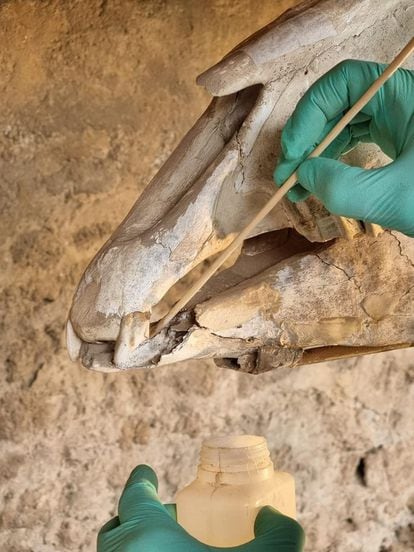Pompeii is an extraordinary time machine that has allowed us to know, like no other archaeological site, what life was like in ancient times.
Not only from humans, but also from fauna and the environment.
The remains of one of its first animals appeared in 1938 among the
lapilli
, solid fragments of lava, like black hail that covers the ground of the Roman city, buried by the relentless eruption of Vesuvius in 79 AD. It was the skeleton of a horse, 1.34 meters high up to the cross, also a victim of the fury of the volcano, which was used to transport goods and which appeared inside a stable, with its head reclined towards a manger and surrounded by straw and other organic remains.
More information
The 159 bombings that destroyed Pompeii for the second time
Restoration work on the skeleton of the so-called Maiuri horse in Pompeii. Pompeii Archaeological Park
Over the decades, the remains of the steed suffered the same fate as much of the site and fell into oblivion and abandonment, devastated by mismanagement and the Camorra, in what became known as "the second destruction of Pompeii".
The gangsters tried to infiltrate the management of the site, buying the staff, and stole pieces.
Now, with the new impulse that the archaeological park is experiencing, modernized for some years by a new Administration, which has promoted the largest excavation campaign in half a century, the animal has returned to the hands of experts, who already work in its restoration to study it and bring it closer to its original appearance.
Restoration of the Maiuri horse skeleton. Pompeii Archaeological Park
It is known as the Maiuri horse from the name of the famous archaeologist who discovered it, Amedeo Maiuri.
The scholar, following the trends of the time, based on a musealization consisting of turning the city into an open-air museum, left the findings where they appeared.
He did the same with the skeleton of the horse, which he placed on its feet on a metal structure, which he covered with a roof tile to protect it from inclement weather.
No one took care of the horse afterwards and the abandonment ended up making a dent in its state of conservation.
The metallic framework ended up damaging the skeleton and the oxidation of the structure affected the color of the bones.
For this reason, the Pompeii Archaeological Park has now begun its restoration.
Restoration of the Maiuri horse skeleton in Pompeii. Pompeii Archaeological Park
Scientists first studied the horse's skeleton with a laser scanner to create a 3D model.
Then they have transferred the remains to the laboratory to disassemble the different parts of the skeleton and subject them to a process of restoration, cleaning and consolidation.
As the archaeologist Luana Toniolo has explained, in a second step, which parts of the bone structure are missing will be evaluated and they will be printed with a 3D printer.
Later, the skeleton will be reassembled on another platform, made of materials more suitable for the site's microclimate, which also facilitate its conservation, and in a more scientifically correct position.
Photo of the Maiuri horse taken in 1941-1942, Pompeii Archaeological Park
An archaeologist-zoologist will supervise each phase of this interdisciplinary project to carry out a scientific study of the horse, which was not carried out at the time of Maiuri, and which will allow more details about these animals and the use made of them in ancient Rome. , as the director of the archaeological park, Gabriel Zuchtriegel, points out.
Study with laser scanner of the skeleton of the Maiuri horse in the archaeological park of PompeiiPompeii Archaeological Park
A few years ago remains of other horses, some still in their ornate harness, were discovered in a villa of a high-ranking Roman military man, outside the city walls. One of the steeds was saddled and ready to go, possibly to help rescue those trying to flee the eruption, which wiped Pompeii and neighboring Herculaneum, Oplontis, and Stabia, thriving cities of the Roman Empire, off the map in just a few hours. the growing tourism of the time, which ended between myth and oblivion.
The cities were washed away by a heat wave of about 400 degrees Celsius and by an avalanche that buried them under a 20 meter thick layer of volcanic material.
Until in the middle of the 18th century the excavations promoted by the King of Naples Carlos de Borbón, later Carlos III of Spain, brought them to light again.

